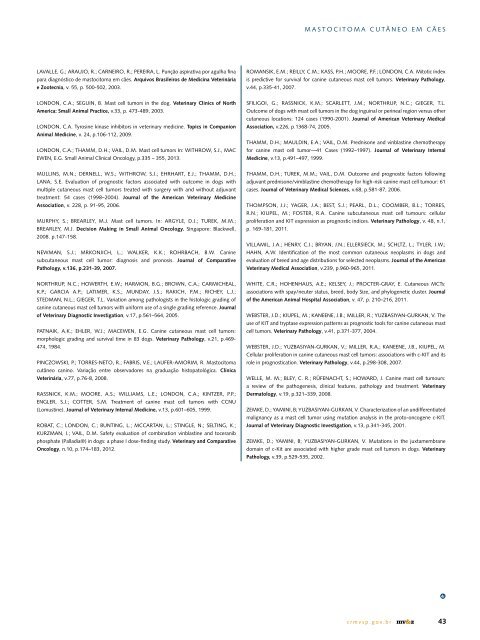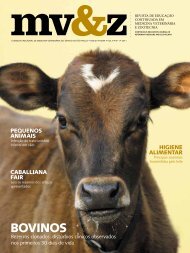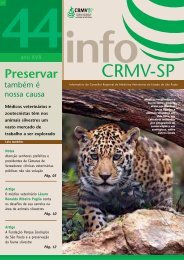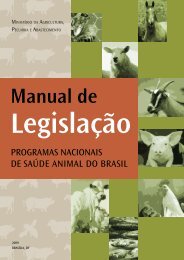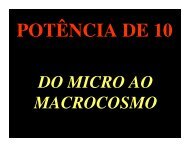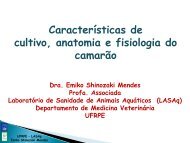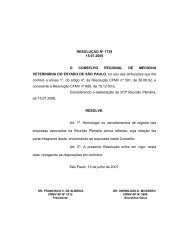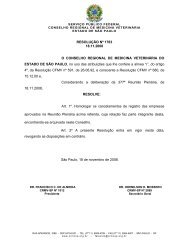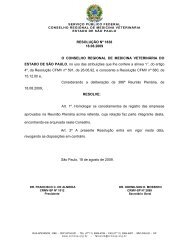mv&z
Vol. 11 - nº 1 - 2013 - CRMV-SP
Vol. 11 - nº 1 - 2013 - CRMV-SP
- No tags were found...
Create successful ePaper yourself
Turn your PDF publications into a flip-book with our unique Google optimized e-Paper software.
M a s t o c i t o m a c u t â n e o e m c ã e sLAVALLE, G.; ARAUJO, R.; CARNEIRO, R.; PEREIRA, L. Punção aspirativa por agulha finapara diagnóstico de mastocitoma em cães. Arquivos Brasileiros de Medicina Veterináriae Zootecnia, v. 55, p. 500-502, 2003.ROMANSIK, E.M.; REILLY, C.M.; KASS, P.H.; MOORE, P.F.; LONDON, C.A. Mitotic índexis predictive for survival for canine cutaneous mast cell tumors. Veterinary Pathology,v.44, p.335-41, 2007.LONDON, C.A.; SEGUIN, B. Mast cell tumors in the dog. Veterinary Clinics of NorthAmerica: Small Animal Practice, v.33, p. 473-489, 2003.LONDON, C.A. Tyrosine kinase inhibitors in veterinary medicine. Topics in CompanionAnimal Medicine, v. 24, p.106-112, 2009.LONDON, C.A.; THAMM, D.H.; VAIL, D.M. Mast cell tumors In: WITHROW, S.J., MACEWEN, E.G. Small Animal Clinical Oncology, p.335 – 355, 2013.SFILIGOI, G.; RASSNICK, K.M.; SCARLETT, J.M.; NORTHRUP, N.C.; GIEGER, T.L.Outcome of dogs with mast cell tumors in the dog inguinal or perineal region versus othercutaneous locations: 124 cases (1990-2001). Journal of American Veterinary MedicalAssociation, v.226, p.1368-74, 2005.THAMM, D.H.; MAULDIN, E.A.; VAIL, D.M. Prednisone and vinblastine chemotherapyfor canine mast cell tumor—41 Cases (1992–1997). Journal of Veterinary InternalMedicine, v.13, p.491–497, 1999.MULLINS, M.N.; DERNELL, W.S.; WITHROW, S.J.; EHRHART, E.J.; THAMM, D.H.;LANA, S.E. Evaluation of prognostic factors associated with outcome in dogs withmultiple cutaneous mast cell tumors treated with surgery with and without adjuvanttreatment: 54 cases (1998–2004). Journal of the American Veterinary MedicineAssociation, v. 228, p. 91-95, 2006.MURPHY, S.; BREARLEY, M.J. Mast cell tumors. In: ARGYLE, D.J.; TUREK, M.M.;BREARLEY, M.J. Decision Making in Small Animal Oncology. Singapore: Blackwell,2008. p.147-158.NEWMAN, S.J.; MRKONJICH, L.; WALKER, K.K.; ROHRBACH, B.W. Caninesubcutaneous mast cell tumor: diagnosis and pronosis. Journal of ComparativePathology, v.136, p.231-39, 2007.THAMM, D.H.; TUREK, M.M.; VAIL, D.M. Outcome and prognostic factors followingadjuvant prednisone/vimblastine chemotherapy for high-risk canine mast cell tumour: 61cases. Journal of Veterinary Medical Sciences, v.68, p.581-87, 2006.THOMPSON, J.J.; YAGER, J.A.; BEST, S.J.; PEARL, D.L.; COOMBER, B.L.; TORRES,R.N.; KIUPEL, M.; FOSTER, R.A. Canine subcutaneous mast cell tumours: cellularproliferation and KIT expression as prognostic indices. Veterinary Pathology, v. 48, n.1,p. 169-181, 2011.VILLAMIL, J.A.; HENRY, C.J.; BRYAN, J.N.; ELLERSIECK, M.; SCHLTZ, L.; TYLER, J.W.;HAHN, A.W. Identification of the most common cutaneous neoplasms in dogs andevaluation of breed and age distributions for selected neoplasms. Journal of the AmericanVeterinary Medical Association, v.239, p.960-965, 2011.NORTHRUP, N.C.; HOWERTH, E.W.; HARMON, B.G.; BROWN, C.A.; CARMICHEAL,K.P.; GARCIA A.P.; LATIMER, K.S.; MUNDAY, J.S.; RAKICH, P.M.; RICHEY, L.J.;STEDMAN, N.L.; GIEGER, T.L. Variation among pathologists in the histologic grading ofcanine cutaneous mast cell tumors with uniform use of a single grading reference. Journalof Veterinary Diagnostic Investigation, v.17, p.561–564, 2005.PATNAIK, A.K.; EHLER, W.J.; MACEWEN, E.G. Canine cutaneous mast cell tumors:morphologic grading and survival time in 83 dogs. Veterinary Pathology, v.21, p.469-474, 1984.PINCZOWSKI, P.; TORRES-NETO, R.; FABRIS, V.E.; LAUFER-AMORIM, R. Mastocitomacutâneo canino. Variação entre observadores na graduação histopatológica. ClínicaVeterinária, v.77, p.76-8, 2008.RASSNICK, K.M.; MOORE, A.S.; WILLIAMS, L.E.; LONDON, C.A.; KINTZER, P.P.;ENGLER, S.J.; COTTER, S.M. Treatment of canine mast cell tumors with CCNU(Lomustine). Journal of Veterinary Internal Medicine, v.13, p.601–605, 1999.ROBAT, C.; LONDON, C.; BUNTING, L.; MCCARTAN, L.; STINGLE, N.; SELTING, K.;KURZMAN, I.; VAIL, D.M. Safety evaluation of combination vinblastine and toceranibphosphate (Palladia®) in dogs: a phase I dose-finding study. Veterinary and ComparativeOncology, n.10, p.174–183, 2012.WHITE, C.R.; HOHENHAUS, A.E.; KELSEY, J.; PROCTER-GRAY, E. Cutaneous MCTs:associations with spay/neuter status, breed, body Size, and phylogenetic cluster. Journalof the American Animal Hospital Association, v. 47, p. 210–216, 2011.WEBSTER, J.D.; KIUPEL, M.; KANEENE, J.B.; MILLER, R.; YUZBASIYAN-GURKAN, V. Theuse of KIT and tryptase expression patterns as prognostic tools for canine cutaneous mastcell tumors. Veterinary Pathology, v.41, p.371-377, 2004.WEBSTER, J.D.; YUZBASIYAN-GURKAN, V.; MILLER, R.A.; KANEENE, J.B., KIUPEL, M.Cellular proliferation in canine cutaneous mast cell tumors: associations with c-KIT and itsrole in prognostication. Veterinary Pathology, v.44, p.298-308, 2007.WELLE, M. M.; BLEY, C. R.; RÜFENACHT, S.; HOWARD, J. Canine mast cell tumours:a review of the pathogenesis, clinical features, pathology and treatment. VeterinaryDermatology, v.19, p.321–339, 2008.ZEMKE, D.; YAMINI, B; YUZBASIYAN-GURKAN, V. Characterization of an undifferentiatedmalignancy as a mast cell tumor using mutation analysis in the proto-oncogene c-KIT.Journal of Veterinary Diagnostic Investigation, v.13, p.341-345, 2001.ZEMKE, D.; YAMINI, B; YUZBASIYAN-GURKAN, V. Mutations in the juxtamembranedomain of c-Kit are associated with higher grade mast cell tumors in dogs. VeterinaryPathology, v.39, p.529-535, 2002.&c r m v s p . g o v . b rmv&z43


